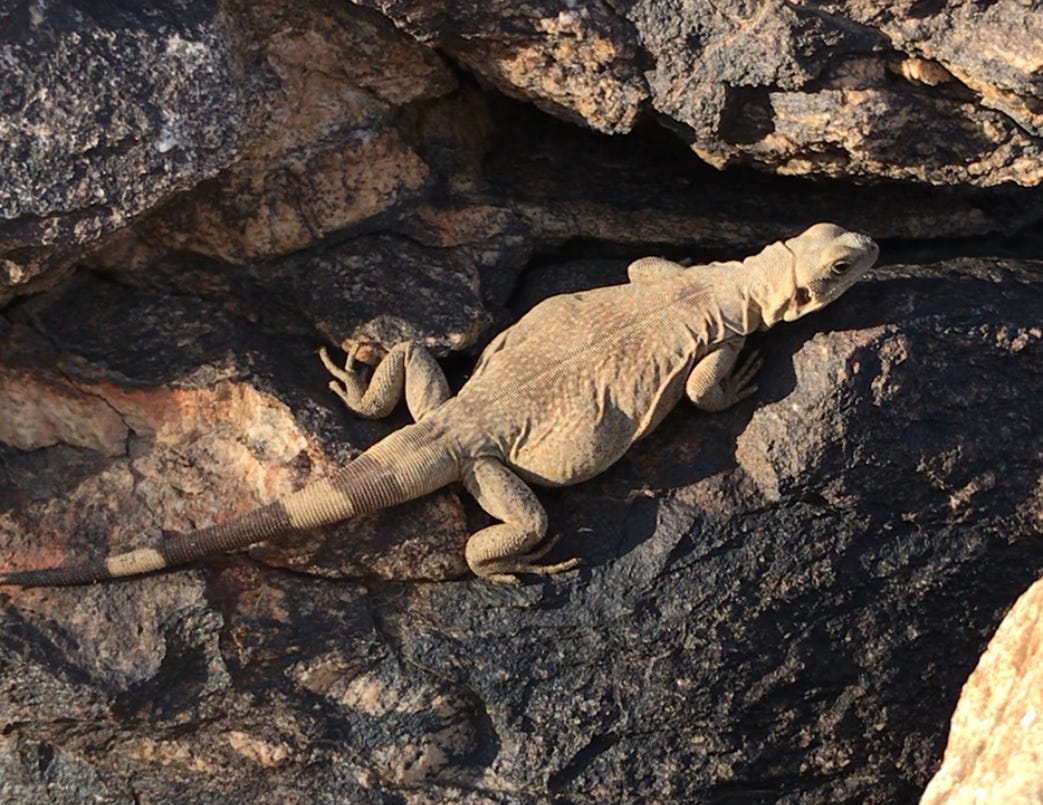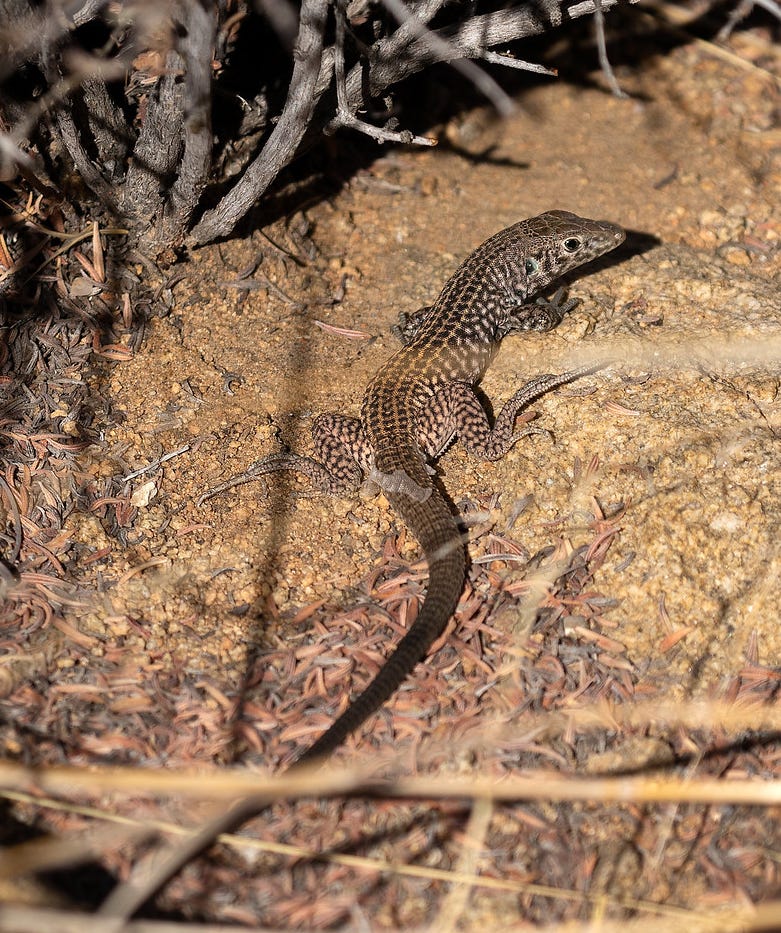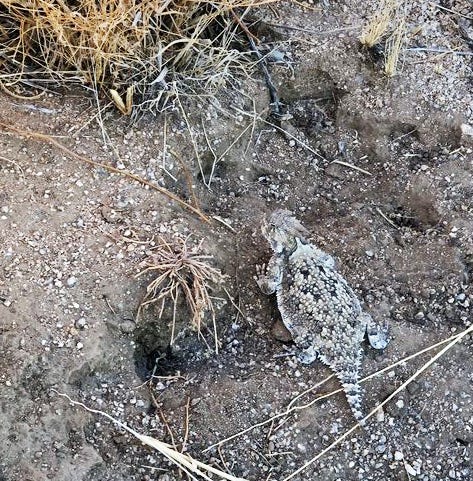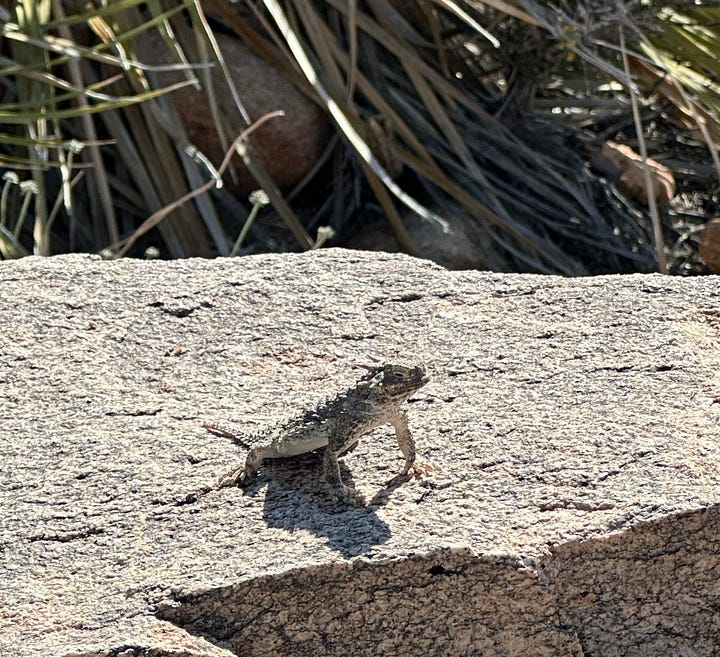WILDLIFE WEDNESDAY: Lady Lizards
The dudes have the flashy moves so let’s give some love to female lizards

Now that it’s finally spring, the desert iguana that hangs out near the porch has been practicing his pushups. He’s been so handsome and impressive, I almost didn’t notice the object of his attentions.
A female desert iguana (lower left) as a male does pushups. (Video Kat Talley-Jones)
Is she impressed? What do you think? When the day warms, it’s hard to miss the side-blotch lizards, whiptails, and chuckwallas looking for love. It makes me giddy.
She Rex
When I first thought I’d write about lady lizards for Wildlife Wednesday, I was just going to focus on whiptails, the long-lined, elegant lizards that insist on darting across roads and trails. A 2017 Twitter post from Joshua Tree National Park had me thinking that the whiptail species that lives around here are all females.
Sadly, this isn’t the case. We are graced here with western or tiger whiptails (Aspidoscelis tigris tigris), which are male and female and reproduce sexually.

Some whiptails, specifically the New Mexico whiptail (Aspidoscelis neomexicanus), consist only of females. These striped beauties produce eggs that don’t need to be fertilized. The offspring are essentially clones of their mothers. The lizards do participate in mating behaviors—one lizard will mount the other and they’ll twine tails, which triggers ovulation in one or both lizards. There are theories about why some lizards species are all-female—benefits include the ability to spread to new habitats if it only takes on individual, a brilliant advantage that gives resilience with habitat loss and climate change. (This is giving me an idea for a science fiction novel….)
The Big Girls
Inquiring minds want to know how spiky horned lizards mate. (Very carefully!) The males have tough underbellies and persist despite females’ very spiny backs. Females are larger than males, which don’t aggressively defend their territories or sport mating colors. Males use their energy looking for females rather than maintain a large body size. Both sexes feast on ants, which are more plentiful in some seasons than others.


Lizard Hands? Human Hands!
There are 18 or so species around here, and they all lay eggs—an activity that will be taking place in the next couple of weeks among our lizard species. Many of them will dig shallow holes with their front claws, like this desert iguana inconveniently laying her eggs next to a driveway:
A female desert iguana digs a hole for her eggs (video courtesy Heidi Heard)
By the way, according to stories told by the Miwok people,1 a grandmother lizard is the reason people have hands instead of paws. In the 1930s, María Copas Frías, a Coast Miwok woman who lived in Marin County, told this story. She explained that Coyote made most animals and people:
Coyote made some wooden people, a man and a woman. He kept them close to his house for four days…and they became my people and the Tomales [Marin] people. He also made mud people. These might be the Sebastopol people [South Pomo].
When the first baby was born. Coyote said, "Oh, my baby is going to have paws like mine." Then Old Lady Lizard said, "No. All my grandchildren are going to be born with five fingers, just like mine." She spread her fingers. So there are [we have] five fingers.
Thank you, lady lizards, for our human hands!
Desert Trumpet is looking for writers! Are you interested? Email your resume and two writing samples to editor@deserttrumpet.org and we’ll be in touch!
Leave your thoughts in the comments below. Please note that we do not allow anonymous comments. Please be sure your first and last name is on your profile prior to commenting. Anonymous comments will be deleted.
Feel free to share this article!
We have reached our goal of $5,000 in paid subscriptions! We are very grateful for support from our community. We know that many communities in the Morongo Basin are economically disadvantaged, so our coverage will always be free. However, if you have the means to support our work, we always appreciate upgrades to a paid subscription. Your upgrade helps keep subscriptions free for those who cannot afford to donate.
Note: Your subscription/donation will be listed as AHA Projects, the name of our fiscal receiver, on your statement.
Emily Taylor mentions this story in her new book, California Lizards and How to Find Them. I highly recommend the book.




Numbers are down this year so far as are those who eat them here in my part of Desert Heights.